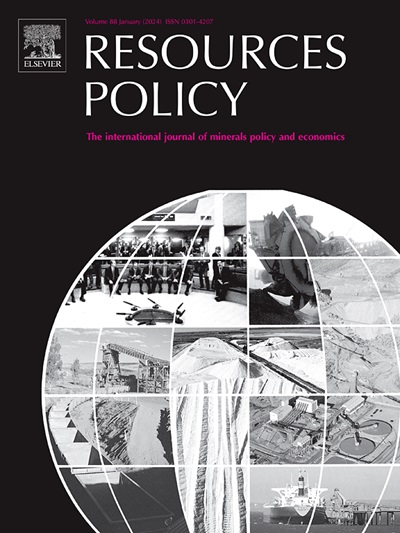U.S. industry practices and attitudes towards reprocessing mine tailings for metal recovery
IF 10.2
2区 经济学
0 ENVIRONMENTAL STUDIES
引用次数: 0
Abstract
Recovery of metals from mine tailings has the potential to reduce environmental liabilities and contribute to circular economy, but implementation is limited. This study uses three methods to examine the state of practice and identify knowledge gaps around tailings reprocessing: 1) a survey of Qualified Persons; 2) a review of U.S. Securities and Exchange Commission (SEC) filings; and 3) a review of the scholarly literature on tailings reprocessing. The survey of Qualified Persons shows that only a quarter of respondents, who are experts authorized to certify technical documents on mineral development in the U.S., have evaluated the reprocessing of tailings. In follow-up interviews, respondents emphasized the complexity of these considerations, encompassing geology, geochemistry, resource estimation, mineral processing, extractive metallurgy, economics, environmental science, and the social and regulatory context. The SEC filings provide an initial indication of the state of practice, showing that companies required to file in the U.S. have only conducted large-scale tailings reprocessing at 27 sites, mostly for gold, predicated on relatively little sampling or formal analysis of the tailings at the sites. The review of 98 scholarly journal articles on metal recovery from tailings shows that none incorporated more than two relevant disciplines. This study brings these three datasets together in a suggested workflow of 20 questions to guide for decision-making on tailings reprocessing, involving interdisciplinary understanding of the technical factors, the regulatory framework, and economic, environmental, and social impact.
美国工业对矿山尾矿再加工回收金属的做法和态度
从矿山尾矿中回收金属有可能减少环境责任和促进循环经济,但执行情况有限。本研究采用三种方法考察尾矿后处理的实践状况和识别知识缺口:1)合格人员调查;2)审查美国证券交易委员会(SEC)的文件;3)对尾矿后处理的学术文献进行了综述。对合格人员的调查显示,只有四分之一的受访者是被授权认证美国矿物开发技术文件的专家,他们对尾矿的再处理进行了评估。在后续访谈中,受访者强调了这些考虑的复杂性,包括地质学、地球化学、资源估计、矿物加工、采掘冶金、经济学、环境科学以及社会和监管背景。美国证券交易委员会的文件提供了实践状况的初步迹象,表明被要求在美国提交文件的公司只在27个地点进行了大规模的尾矿再处理,主要是为了黄金,基于对这些地点的尾矿进行相对较少的采样或正式分析。对98篇关于从尾矿中回收金属的学术期刊文章的审查表明,没有一篇文章包含两个以上的相关学科。本研究将这三个数据集整合在一个包含20个问题的建议工作流中,以指导尾矿后处理的决策,涉及对技术因素、监管框架以及经济、环境和社会影响的跨学科理解。
本文章由计算机程序翻译,如有差异,请以英文原文为准。
求助全文
约1分钟内获得全文
求助全文
来源期刊

Resources Policy
ENVIRONMENTAL STUDIES-
CiteScore
13.40
自引率
23.50%
发文量
602
审稿时长
69 days
期刊介绍:
Resources Policy is an international journal focused on the economics and policy aspects of mineral and fossil fuel extraction, production, and utilization. It targets individuals in academia, government, and industry. The journal seeks original research submissions analyzing public policy, economics, social science, geography, and finance in the fields of mining, non-fuel minerals, energy minerals, fossil fuels, and metals. Mineral economics topics covered include mineral market analysis, price analysis, project evaluation, mining and sustainable development, mineral resource rents, resource curse, mineral wealth and corruption, mineral taxation and regulation, strategic minerals and their supply, and the impact of mineral development on local communities and indigenous populations. The journal specifically excludes papers with agriculture, forestry, or fisheries as their primary focus.
 求助内容:
求助内容: 应助结果提醒方式:
应助结果提醒方式:


